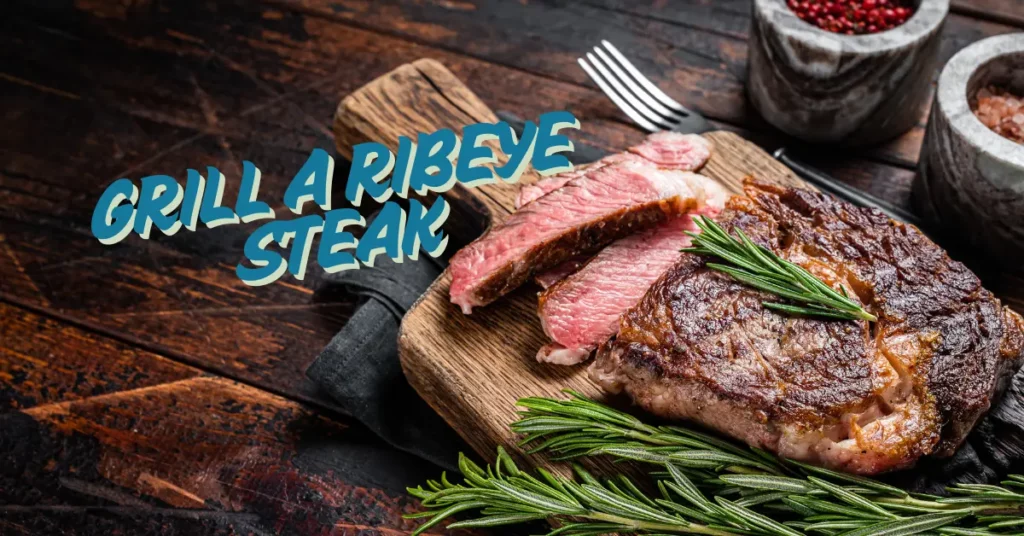This post may contain affiliate links. If you use these links to buy something we may earn a small commission. Thanks.
Ribeye steaks are a favorite among grilling enthusiasts for their rich marbling and exceptional flavor. Grilling a ribeye to perfection requires the right technique and attention to detail. In this guide, we’ll walk you through each step to help you achieve a perfectly grilled ribeye steak that’s juicy, tender, and full of flavor.
Choosing the Right Ribeye Steak
The first step to a great grilled ribeye is selecting the right cut:
- Types of Ribeye: Decide between bone-in or boneless ribeye. Bone-in ribeye often offers enhanced flavor and helps retain moisture during cooking, while boneless is easier to handle.
- Quality: Opt for USDA Prime or Choice grade for the best marbling. Marbling is the fat distribution within the meat that adds flavor and tenderness.
- Thickness: A ribeye that’s 1 to 1.5 inches thick is ideal for grilling as it allows for a good sear without overcooking the inside.
When choosing your steak, pay attention to the color and freshness. A bright red color with creamy white fat is a good indicator of quality. Avoid steaks with grayish or brownish tones as they may not be as fresh.
Preparing the Steak
Proper preparation sets the foundation for a flavorful steak:
- Thawing: Ensure the steak is fully thawed to cook evenly. For frozen steaks, transfer them to the refrigerator at least 24 hours before grilling.
- Patting Dry: Use paper towels to remove excess moisture from the surface of the steak. This step is crucial for achieving a beautiful crust during the searing process.
- Seasoning:
- Stick to the basics with kosher salt and freshly cracked black pepper. These enhance the natural flavors of the steak.
- For a flavor boost, you can use rubs or marinades with ingredients like garlic, rosemary, or smoked paprika.
- Timing is key: season at least 40 minutes before grilling or immediately before placing the steak on the grill.

For those looking to experiment, consider a dry brine by sprinkling salt over the steak and letting it rest uncovered in the refrigerator for a few hours or overnight. This technique helps the salt penetrate the meat for deeper flavor.
Prepping the Grill
Whether you’re using a gas, charcoal, or pellet grill, preparation is essential:
- Grill Type:
- A charcoal grill imparts a smoky flavor that’s hard to beat.
- Gas grills provide consistent heat and convenience.
- Pellet grills combine ease and smoky flavor.
- Preheating: Preheat the grill to 450–500°F for proper searing. A hot grill is essential to create a caramelized crust without overcooking the interior.
- Oil the Grates: Use a high-smoke-point oil like canola or grapeseed oil to prevent sticking and ensure even cooking.
To check if your grill is ready, hold your hand a few inches above the grates. If you can only keep it there for 1–2 seconds, the grill is sufficiently hot.
Grilling the Ribeye Steak
Now it’s time to cook your ribeye:
- Searing: Place the steak on the grill over direct high heat. Sear each side for 2–3 minutes to create a flavorful crust. Avoid moving the steak too much during this process to allow for proper browning.
- Cooking to Doneness: After searing, move the steak to indirect heat to cook through. Use a meat thermometer for precision:
- Rare: 120–130°F
- Medium Rare: 130–135°F
- Medium: 135–145°F
- Medium Well: 145–155°F
- Well Done: 155°F+
Check the temperature in the thickest part of the steak to ensure accuracy. Remember, the temperature will rise by 5–10°F during resting.
For an added smoky flavor, consider adding wood chips or chunks to your charcoal or pellet grill. Hickory, oak, and mesquite are great options for enhancing the taste of your ribeye.
Resting the Steak
After grilling, let the steak rest for 5–10 minutes. This step allows the juices to redistribute, ensuring a tender and flavorful bite in every piece. Cover the steak loosely with aluminum foil during resting to keep it warm without trapping steam, which could soften the crust.
Optional Enhancements
- Toppings: Enhance your steak with garlic butter, compound butter infused with herbs, or a sprinkling of blue cheese crumbles. For a gourmet touch, try a red wine reduction or balsamic glaze.
- Sides: Serve with grilled vegetables, creamy mashed potatoes, or a crisp green salad for a complete meal. Roasted asparagus, garlic bread, or a loaded baked potato are also excellent pairings.
Consider pairing your meal with a robust red wine, such as a Cabernet Sauvignon or Malbec, to complement the rich flavors of the ribeye.
Serving the Ribeye Steak
For the best presentation and texture:
- Slice the steak against the grain to break up the muscle fibers, making each bite more tender.
- Arrange slices on a plate and garnish with fresh herbs for visual appeal. Adding a sprinkle of flaky sea salt before serving can further elevate the flavor.
When serving a crowd, consider slicing the steak and arranging it on a platter with toppings and sides for a family-style presentation.
Troubleshooting and Tips
- Flare-ups: If flare-ups occur due to dripping fat, move the steak to a cooler part of the grill temporarily.
- Overcooking: Use a thermometer to avoid overcooking. Remember, steak continues to cook slightly after being removed from the grill.
- Perfect Crust: Pat the steak dry and ensure the grill is hot enough before searing. Avoid overcrowding the grill to maintain consistent heat.
For an extra crispy crust, consider finishing your steak with a reverse sear. Cook the steak over indirect heat until it’s just below your desired doneness, then sear it over high heat for 1–2 minutes per side.
Conclusion
Grilling a ribeye steak is an art that combines proper preparation, precise cooking, and attention to detail. By following these steps, you can create a steak that’s rich in flavor and perfectly cooked. Experiment with seasonings, grill types, and sides to make the experience uniquely yours. Fire up your grill and enjoy the savory satisfaction of a perfectly grilled ribeye steak!
Remember, practice makes perfect. Each time you grill a ribeye, you’ll refine your technique and discover new ways to enhance the flavor and texture. Whether you’re cooking for yourself, family, or friends, a well-grilled ribeye is always a showstopper at the table.
